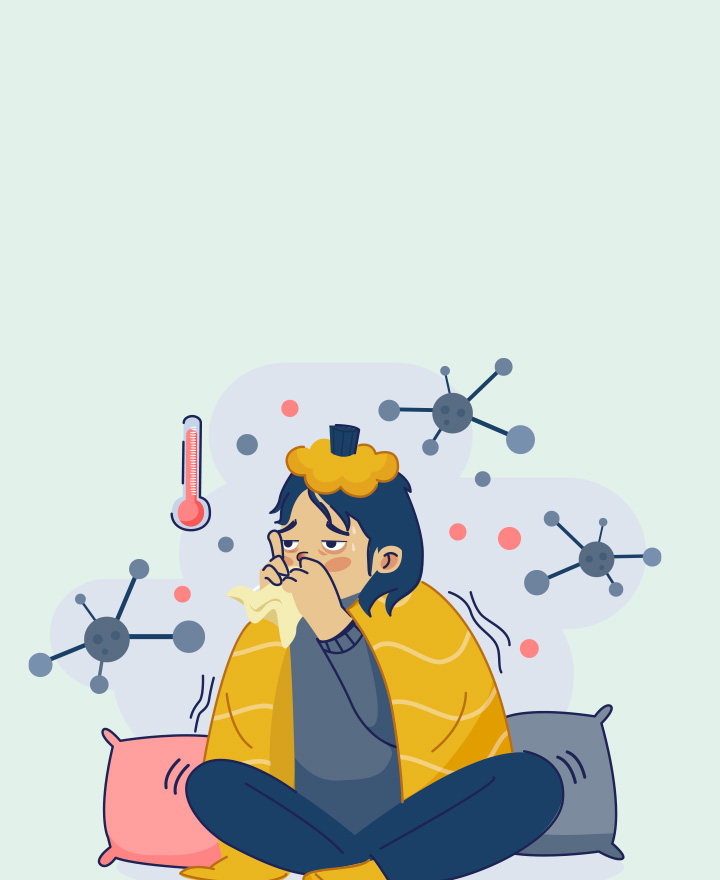

What is Monkeypox Virus?
Monkeypox is a viral infection caused by the monkeypox virus. The virus was first traced in monkeys at a research facility in Denmark in 1958. This infectious disease is highly contagious, and the initial symptoms of the disease are somewhat like smallpox. The symptoms in the first stage of the disease include fever and chills, body aches, headache, and general fatigue. The virus causing this disease may get transmitted through animal-to-human contact, human-to-human contact, contact with environmental factors, and more. Take a look at this article to learn more about the infection.
Symptoms
The monkeypox virus has two main variants: Clade I (which appeared in Central Africa) and Clade II (which appeared in West Africa). A third, less severe subtype of the West African variant is responsible for the current viral outbreak. This third new variant is recognised worldwide as the Clade IIb.
The symptoms of the monkeypox disease manifest in stages. The symptoms may vary from person to person in terms of severity, but the most common signs of the infection are:
1. First Stage Symptoms (1-3 days before the appearance of the rash)
The initial or first-stage symptoms are flu-like symptoms. The common signs and symptoms during this phase are —
• Fever:
This is, in fact, the earliest symptom, lasting for about 1 to 3 days before the rash appears.
• Chills:
Intense shivering or chills accompanies the fever in most cases.
• Myalgia:
Muscular pain or myalgia is another common symptom of the disease. It is a generalised muscular ache that mostly hits the back muscles.
• Headache:
Headaches may range from moderate to severe.
• Fatigue:
Excessive tiredness and weakness are other common symptoms.
• Swollen Lymph Nodes:
Lymph nodes in the groin, armpit, and neck may become swollen and painful.
2. Rash on the Skin (Appears 1-3 days after fever)
As the infection progresses, rashes appear on the skin. In most cases, the rashes first appear on the face and then gradually spread to the other parts of the body, including the mouth, genitals, hands, and feet. Initially, the rashes appear as reddish spots on the skin. Later, they become papules or red bumps, then vesicles or watery blisters, and finally, pustules or pus-filled lesions. After pustules, the rashes turn to scabs. The rashes are painful and itchy, causing much discomfort for the infected person.
3. Other Symptoms
Apart from the above symptoms, some patients infected by the monkeypox virus may show symptoms such as conjunctivitis, cough, and sore throat.
The symptoms of monkeypox infection usually last for 2 to 4 weeks. The skin rashes take some time to heal and the scabs that develop in the final phase of the infection fall off eventually.
Causes
The monkeypox virus triggers this viral infection. The virus belongs to the orthopoxviral genus. The smallpox virus, i.e. variola virus, also belongs to the same genus. The main causes and transmission modes for this viral infection include the following —
• Animal-to-Human Transmission
Animal-to-human transmission may occur in three ways — direct contact with the infected animals, eating the undercooked flesh of infected animals, and through scratches or bites of the infected animals.
• Human-to-Human Transmission
Human-to-human transmission may also occur in three ways — contact with the rashes and lesions on the infected person’s skin, contact with contaminated objects like the bed linen, clothing, etc., used by the patient, and contact with the respiratory droplets from the infected patient.
• Environmental Triggers
Environmental factors come into play, especially in areas where the monkeypox viral infection is endemic. The transmission rate in these areas could be high due to large-scale interaction with the affected wildlife.
• Maternal Transmission
Infected women who are pregnant may pass the infection to the foetus through the placental exchange, causing congenital infection.
Conclusion
Monkeypox viral infection often subsides on its own. Timely medical intervention may help avoid unwanted complications. Monkeypox treatment usually begins with diagnosis, isolation, flu management, and prescribing painkillers. These steps can curb the spread of the infection, alleviating the symptoms of the monkeypox infection and checking its severity. In Africa, where the transmission rates are high, doctors use smallpox vaccines for people who are eager to get a vaccine for monkeypox. Smallpox vaccines have shown promising results in reducing a person’s vulnerability to the infection. If you suspect getting infected, seek timely medical help to avoid complications.
One of the important components of our overall wellness is also being financially secured. Healthcare emergencies can happen any time, but a good health insurance policy can protect you from such uncertain situations. To know more about Wellness and other health related tips, visit the wellness corner.
Source: who.int
Disclaimer: This blog provides general information and discussions about health and related subjects. The information and other content provided in this blog, website or in any linked materials are not intended and should not be considered, or used as a substitute for, medical advice, diagnosis or treatment. Kindly contact your Doctor before starting a new medicine or health regime.
Related Articles
Chickenpox vs Monkeypox in Monsoon: Key Differences and Risks
Everything You Need to Know About Monkeypox
Published on November 29, 2024


 Health Insurance
Health Insurance  Travel Insurance
Travel Insurance  Car Insurance
Car Insurance  Cyber Insurance
Cyber Insurance  Critical Illness Insurance
Critical Illness Insurance
 Pet Insurance
Pet Insurance
 Bike/Two Wheeler Insurance
Bike/Two Wheeler Insurance  Home Insurance
Home Insurance  Third Party Vehicle Ins.
Third Party Vehicle Ins.  Tractor Insurance
Tractor Insurance  Goods Carrying Vehicle Ins.
Goods Carrying Vehicle Ins.  Passenger Carrying Vehicle Ins.
Passenger Carrying Vehicle Ins.  Compulsory Personal Accident Insurance
Compulsory Personal Accident Insurance  Travel Insurance
Travel Insurance  Rural
Rural